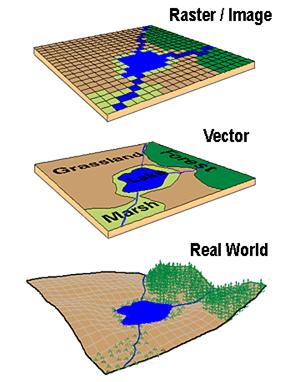
- #Raster and vector data model in gis registration#
- #Raster and vector data model in gis software#
- #Raster and vector data model in gis series#
- #Raster and vector data model in gis download#
- #Raster and vector data model in gis free#
They represent data in different ways and are used for different applications.

#Raster and vector data model in gis download#
#Raster and vector data model in gis software#
Most data loaded into a GIS software program tends to be in vector data. As of 2020, it has 250,000+ open data sets from over 5,000+ organizations worldwide. Vector data is the most common type of GIS data.Ultimately, there is nothing more thorough for GIS data than the Esri Open Data Hub. Alternatively, you can search by topic or location and download data in multiple GIS formats. In any case, the search is convenient with a map preview of the extent and table. Despite the extra effort, this is still arguably your best chance to find exactly what you’re looking for. In some cases, you’ll have to sift through piles of data because they’re not conveniently merged into one.
#Raster and vector data model in gis free#
For this reason, we have it at the top of our list of free GIS data. You can also provide optional input depending on your data requirements. In the dialogue specify the input raster layer and output file where your vector layer will be saved. For example, it now houses over 250,000+ open data sets from 5,000+ organizations worldwide. To open the Raster to Vector tool dialogue click on Raster Conversion Polygonize (Raster to Vector). a road can be represented as a line at a smaller scale or as a polygon at a larger scale.The Esri Open Data Hub is a hidden gold mine of free GIS data. A real-world entity could be represented by different types of vector features depending on the map scale used in an application (e.g.
#Raster and vector data model in gis series#
In the above figure, the real world is represented by a series of lines (roads and highways) and one polygon (the river). Polygons are closed areas that can be made up of a circuit of line segments. We know the two main data models and graphics are vector and raster data. But vectorization transforms rasters in vectors. Lines are spatial objects made up of connected points (nodes) that have no width. By: GISGeography Last Updated: NovemHow is Rasterize Different From Vectorize Rasterization converts vectors into rasters. Points are spatial objects with no area but can have attached attributes since they are a single set of coordinates (X and Y) in a coordinate space.

A vector representation is composed of three main elements: points, lines, and polygons. The concept assumes that space is continuous, rather than discrete, which gives an infinite (in theory) set of coordinates. In the above figure, the real world (shown as an aerial photograph) is simplified as a grid where the color of each cell relates to an entity such as a road, highway, or river. For a large grid, the resolution is fine, but at the expense of much larger storage space. For a small grid, the resolution is coarse but the required storage space is limited. Resolution is an important concern in raster representations. triangles and hexagons), the square is the most commonly used. A raster representation also relies on tessellation: geometric shapes that can completely cover an area.
#Raster and vector data model in gis registration#
This allows for registration with a geographic reference system. Features are divided into cellular arrays and a coordinate (X,Y) is assigned to each cell, as well as a value. Grid cells are the most common raster representation. Each unit is generally similar in size to another. Based on a cellular organization that divides space into a series of units. Two representational models are dominant raster (grid-based) and vector (line-based): A GIS data model enables a computer to represent real geographical elements as graphical elements. In this model, space is not quantized into discrete grid cells like the raster model.

Representing the “real world” in a data model has been a challenge for GIS since their inception in the 1960s. In contrast to the raster data model is the vector data model. We use these models regularly in geographic information systems (GIS), yet perhaps we do not give enough consideration to the generic or intrinsic differences.


 0 kommentar(er)
0 kommentar(er)
